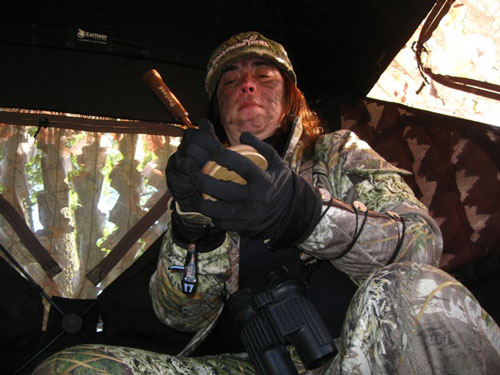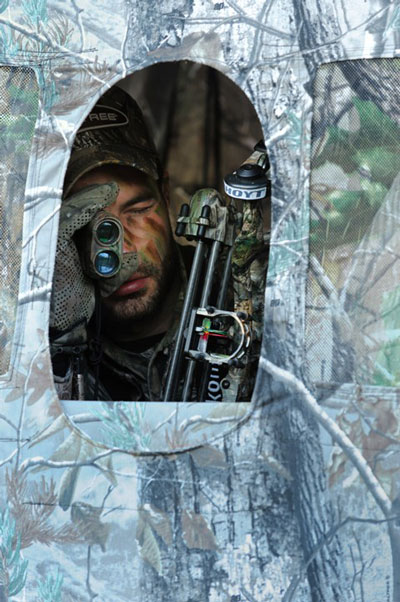 There are those who would have you believe turkeys are worthy of McArthur Foundation Grants, mostly those wanting to convince you they know something you don’t in way of selling product. In fact, I seem to have little trouble killing turkeys with bow, normally several each spring. I don’t consider myself a master turkey caller by any stretch of the imagination. And I’m rather impatient really. So what’s the big secret? Simple: Put away the shotgun and just do it. Of course there’s just a tad more to it than this, so here we go.
There are those who would have you believe turkeys are worthy of McArthur Foundation Grants, mostly those wanting to convince you they know something you don’t in way of selling product. In fact, I seem to have little trouble killing turkeys with bow, normally several each spring. I don’t consider myself a master turkey caller by any stretch of the imagination. And I’m rather impatient really. So what’s the big secret? Simple: Put away the shotgun and just do it. Of course there’s just a tad more to it than this, so here we go.
Get Away From People
“You haven’t bowhunted South Carolina turkeys!” says the frustrated bowhunter. That’s true (though I’ve killed tough birds in Alabama and Georgia), nor do I wish to. If you want regular success on bow turkeys, shun areas daily hammered by gun-hunting pressure. Seek the naïve and uneducated instead. This can mean traveling out of state, farther from large population centers, or hiking into remote areas, even true wilderness. That said, you can kill the toughest ones (like those Alabama and Georgia birds I’ve mentioned), but you simply won’t do it as often and without luck on your side. Too, not every bird’s a candidate for close-range encounters. Bowhunting turkey is about persistence, finding that bird among many willing to saunter in and offer a viable shot. If a bird balks after many hours of concerted effort, look for another candidate.
Gear Up For Gobblers
Aside from better ground and a very basic understanding of calling, you’ll need some special equipment. First, let me address calling, because this seems to cause the most insecurity among spring turkey hunters. Basic calls work fine for even the most wary birds. In fact, more often than not, very basic calls are best. When in doubt call minimally—just enough to keep a bird moving your way, no more, no less.
Your must-have turkey-hunting gear list includes whatever call suits your sensibilities (box, slate or mouth call), a highly portable pop-up blind or 3-D/ghillie camouflage, a pair of turkey decoys (jake and hen), and wide-cutting mechanical broadheads.
 Pop-ups have made turkey hunting easy. Only a stupid bird would saunter right up to a conspicuous cloth blind, but that’s exactly what they’ll do when your calls do their work. Pop-ups make the conspicuous draw cycle invisible to the wariest gobblers, and can even be set on wide-open ground without raising suspicion. Also, due to their highly-portable nature (most setting up/breaking down in minutes), staying one step ahead of developments is easy. Sometimes balking birds need only be addressed from a different angle to turn the tables. Remember, persistence is everything.
Pop-ups have made turkey hunting easy. Only a stupid bird would saunter right up to a conspicuous cloth blind, but that’s exactly what they’ll do when your calls do their work. Pop-ups make the conspicuous draw cycle invisible to the wariest gobblers, and can even be set on wide-open ground without raising suspicion. Also, due to their highly-portable nature (most setting up/breaking down in minutes), staying one step ahead of developments is easy. Sometimes balking birds need only be addressed from a different angle to turn the tables. Remember, persistence is everything.
Three-D or Shaggie outfits (Rancho Safari) are another option, especially in areas requiring long hikes in rough country. Leafy- or shaggy-covered outfits break up the human outline, create depth and concealment lacking in flat, printed camo. I’ve drawn on birds eyeing me suspiciously without reaction. (Though don’t count on it every time!)
Decoys create an attraction to bring birds closer, and, once they’re in range, distraction from you drawing your bow, especially outside of pop-up blinds. The jake/hen combination works well because it creates competition. Any mature gobbler arriving on the scene will be convinced the young upstart’s stealing the goodies. In a blind situation I set decoys practically right under shooting ports, within five yards of the blind. This results in the closest shots possible, even if a tom hangs. When operating from the ground, I normally situate decoys so birds must pass my position while addressing the fakes, attention directed forward and past my sitting form.
You can kill turkeys with standard big-game broadheads, but the wide-cutting mechanical’s best for turning marginal hits (say, a gut shot) into a lethal ending. Here we’re talking 1.5- to 2-inch cutting diameters; the extra cutting action also imparts shock on impact. “Head-loppers” (Aerodynamic Solutions’ Gobbler Guillotine, for example) are another option, but day in and day out, mechanicals assure a quick kill and longer-range capabilities.
Aim & Range Correctly
Of course killing turkeys effectively means hitting them solidly in the middle of the body, centering a baseball-sized target. In turkey hunting, your maximum effective range must often be adjusted, normally to shots inside 25 yards even if you can confidently kill a deer at 40. Turkey hunting is an ongoing learning process. At first you’ll be frustrated as often as not, but eventually it all clicks into place and you’ll find yourself thinking, “Wow, turkey are stupid!”






